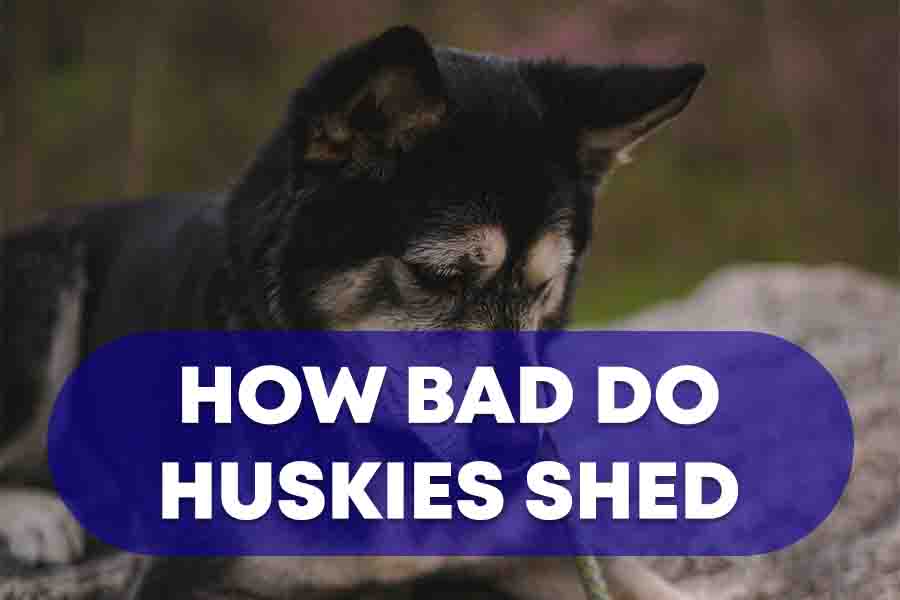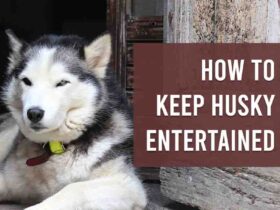With their striking appearance and captivating personalities, Siberian Huskies have long been a favorite among dog enthusiasts. However, alongside their charm comes a well-known challenge: shedding. The question plagues potential Husky owners is, “How bad do Huskies shed?” Understanding the intricacies of Husky shedding patterns, their unique double coat, and the factors that influence this phenomenon is essential for anyone considering bringing one of these beautiful dogs into their home. In this comprehensive guide, we will explore the world of Husky shedding, dispel common myths, and provide practical tips for managing and embracing the beautiful, albeit occasionally hairy, life with a Siberian Husky.
How Bad Do Huskies Shed?
Huskies are renowned for their heavy shedding. They have a double coat designed to protect them in cold climates, which means they shed year-round. The shedding can be incredibly intense during seasonal transitions in spring and fall when they “blow their coat,” shedding their undercoat to adapt to changing temperatures. Regular grooming, including brushing and bathing, is essential to manage Husky shedding effectively. While their shedding can be significant, their love and companionship often make it a worthwhile trade-off for dedicated Husky owners.
Factors Influencing Husky Shedding
Several factors influence shedding in Huskies, and understanding these factors can help you manage and mitigate the amount of hair your Husky sheds. Here are the key factors that contribute to Husky shedding:
- Genetics: Your Husky’s genetics play a significant role in determining their shedding patterns. Some Huskies may naturally shed more than others due to their genetic predisposition. It’s important to note that even within the same litter, individual Huskies may vary in their shedding intensity.
- Climate and Season: Climate and environmental conditions can influence Husky shedding. Huskies have adapted to cold climates, and their shedding tends to be more pronounced in response to temperature changes. In colder regions, they may grow a thicker winter undercoat and shed less in the summer. Conversely, Huskies in warmer areas may shed more consistently throughout the year.
- Diet and Nutrition: The quality of your Husky’s diet can affect the health of their coat and, consequently, shedding. A balanced diet with essential fatty acids, such as Omega-3 and Omega-6, can promote a healthy coat and potentially reduce excessive shedding. Consult with your veterinarian for dietary recommendations tailored to your Husky’s needs.
- Grooming Practices: Proper grooming plays a critical role in managing Husky shedding. Regular brushing helps remove loose fur, distribute natural oils, and prevent matting. Brushing your Husky a few times a week can significantly reduce the amount of hair on your furniture and floors. Additionally, occasional baths using dog-specific shampoos and conditioners can keep the coat clean and healthy.
- Health Factors: Your Husky’s overall health can impact shedding. Skin conditions, allergies, hormonal imbalances, and other health issues may contribute to excessive shedding. Regular veterinary check-ups can help identify and address any underlying health concerns that affect your Husky’s coat.
- Age and Hormonal Changes: Your Husky age can also influence shedding. Puppies typically shed their puppy coat as they grow into adulthood, and female Huskies may experience increased shedding during their heat cycle. Neutering or spaying can also affect hormonal changes that may influence shedding.
- Stress and Anxiety: Stress and anxiety can sometimes lead to increased shedding in Huskies. Significant life changes, such as moving to a new home or adding a new pet, can trigger stress-related shedding. Providing a stable and comfortable environment can help reduce stress-induced shedding.
Understanding these factors and tailoring your care routine can help you effectively manage shedding in your Husky. While Huskies are known for their shedding, with the right approach and attention to their unique needs, you can minimize the impact of shedding on your home and enjoy a happy and healthy life with your furry friend.
Managing Husky Shedding
Managing Husky shedding is a crucial aspect of caring for this breed. Huskies are known for their heavy shedding due to their double coat, but with the right strategies and grooming practices, you can effectively manage and reduce the amount of hair they leave behind. Here are several essential tips for managing Husky shedding:
- Regular Brushing: Brush your Husky’s coat regularly, ideally several times a week, to remove loose fur and prevent matting. Appropriate brushes, such as slicker brushes and undercoat rakes, can effectively capture loose hair. Pay extra attention during shedding seasons.
- Bathing and Hygiene: While Huskies don’t require frequent baths, occasional bathing using dog-specific shampoos and conditioners can help keep their coat clean and healthy. Clean fur is less likely to mat and trap loose hair.
- Nutrition: Ensure your Husky receives a balanced diet of essential fatty acids, such as Omega-3 and Omega-6. Proper nutrition can contribute to a healthier coat and potentially reduce shedding. Consult with your veterinarian for dietary recommendations.
- Health Check-ups: Regular vet check-ups are essential to address any underlying health issues that might contribute to excessive shedding. Allergies, skin conditions, and hormonal imbalances can impact the quality of your Husky’s coat.
- Grooming Tools: Invest in high-quality grooming tools designed for Huskies. These tools are designed to remove loose hair and effectively maintain the coat’s health. Using the right tools can make a significant difference in managing shedding.
- Seasonal Shedding Precautions: Be prepared for the more intense shedding during spring and fall. During these seasons, increase your grooming efforts and consider using a shedding blade or de-shedding tool to help remove the undercoat.
- Control Allergens: If you or someone in your household has allergies, take extra precautions to control allergens. Use air purifiers, wash bedding and curtains regularly, and vacuum with a pet-specific vacuum cleaner.
- Regular Vet Care: Spaying or neutering your Husky can sometimes affect hormonal changes and shedding patterns. Consult with your veterinarian for guidance on the timing of these procedures.
- Maintain a Clean Home: Regularly clean your home to minimize the accumulation of dog hair. Use lint rollers vacuum cleaners with pet attachments, and wash pet bedding frequently.
- Embrace the Husky Lifestyle: Finally, embrace the joys and challenges of owning a Husky, including the shedding. While their shedding may require extra effort in grooming and cleaning, Huskies’ loyalty, love, and unique personality often make it all worth it for their dedicated owners.
By implementing these strategies and staying proactive in your Husky’s grooming and health care, you can successfully manage their shedding and enjoy a happy, healthy, and clean environment for you and your beloved Husky.
Tips For Reducing Shedding In Your Home
Reducing shedding in your home, particularly when you share it with a breed like the Husky, known for its heavy shedding, can be an ongoing challenge. However, with consistent efforts and effective strategies, you can minimize the impact of loose dog hair on your living space. Here are more detailed tips for managing and reducing shedding in your home:
Regular Grooming: A consistent grooming routine is the cornerstone of managing Husky shedding. Brush your Husky several times a week, especially during shedding seasons, using appropriate grooming tools like undercoat rakes, slicker brushes, and de-shedding combs. Removing loose fur before it ends up on your furniture and floors will significantly reduce the amount of hair around your home.
Outdoor Grooming: Whenever possible, perform grooming sessions outdoors. This way, the loose fur is less likely to spread inside your house. Designate a specific spot in your yard for brushing and make cleanup more accessible with a rake or broom.
High-Quality Vacuum Cleaner: Invest in a high-quality vacuum cleaner specifically designed for homes with pets. Look for models equipped with powerful suction and pet-specific attachments, such as upholstery brushes and crevice tools. Regularly vacuum your carpets, rugs, and furniture, paying particular attention to high-traffic areas and your Husky’s favorite spots.
Wash Pet Bedding: Frequently wash your Husky’s bedding, blankets, and toys to prevent the accumulation of hair and odors. Use pet-safe laundry detergents to ensure your dog’s belongings are clean and fresh.
Washable Slipcovers: Consider using washable slipcovers for couches and chairs if your furniture allows. These can be easily removed and cleaned when needed, sparing your furniture from excessive hair buildup.
Hardwood or Tile Flooring: If you have the option, choose hard flooring surfaces like hardwood or tile, as they are easier to clean than carpets. You can still incorporate area rugs with non-slip pads to define pet-friendly zones in your home.
Humidifier and Proper Ventilation: Maintaining the correct humidity levels in your home can help reduce static electricity, which can attract pet hair. Proper ventilation can also aid in circulating and removing airborne hair particles.
Minimize Stress: Huskies may shed more when stressed or anxious. Provide a stable and loving environment for your dog to reduce stress-related shedding. Regular exercise, mental stimulation, and positive interactions can help keep your Husky content.
Consult a Professional Groomer: If you find managing your Husky’s shedding particularly challenging, consider scheduling regular appointments with a professional groomer. They can provide deep grooming and de-shedding services to keep shedding at bay.
Bottom Line
While Huskies are undoubtedly prolific shedders, with proper care, grooming, and understanding of their unique coat, you can enjoy the companionship of these incredible dogs without being overwhelmed by fur. Shedding may be a part of the Husky experience, but it shouldn’t deter you from sharing your life with these loyal and spirited creatures. With the proper knowledge and commitment, you can navigate Husky shedding and revel in the joys of having a Siberian Husky as a cherished member of your family.
FAQ’s
What causes Huskies to shed a lot?
Huskies shed a lot due to their double coat, genetics, shedding seasons (spring and fall), climate, diet, grooming practices, health factors, age, and hormonal changes. Their double coat is designed for insulation and protection, making them heavy shedders compared to single-coated breeds. Regular grooming and nutrition play vital roles in managing their shedding.
Do Huskies shed when they are stressed?
Yes, Huskies, like many other dog breeds, can shed more when stressed. Stress and anxiety can trigger increased shedding as a physiological response. Managing their environment and providing a calm, stable atmosphere can help reduce stress-related shedding in Huskies.
Do Huskies shed when they are stressed?
Huskies can shed heavily in winter due to their natural adaptation to cold weather. They grow a thicker undercoat for insulation, and indoor heating and reduced daylight hours can disrupt their shedding cycle. Stress and changes in routine may also contribute to increased shedding. Regular grooming can help manage winter shedding.






Leave a Reply